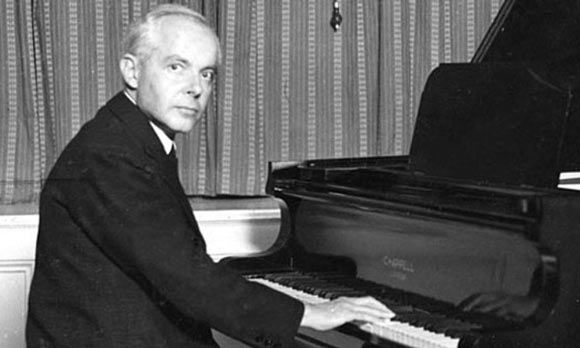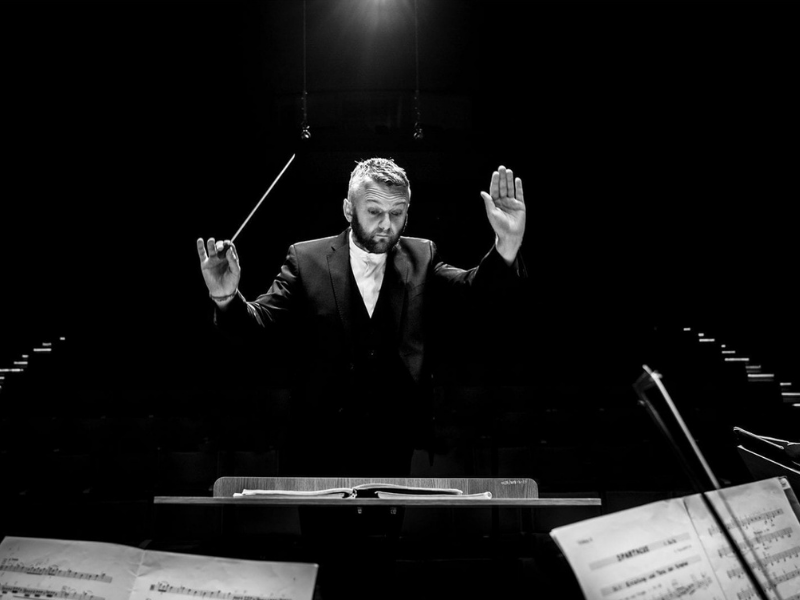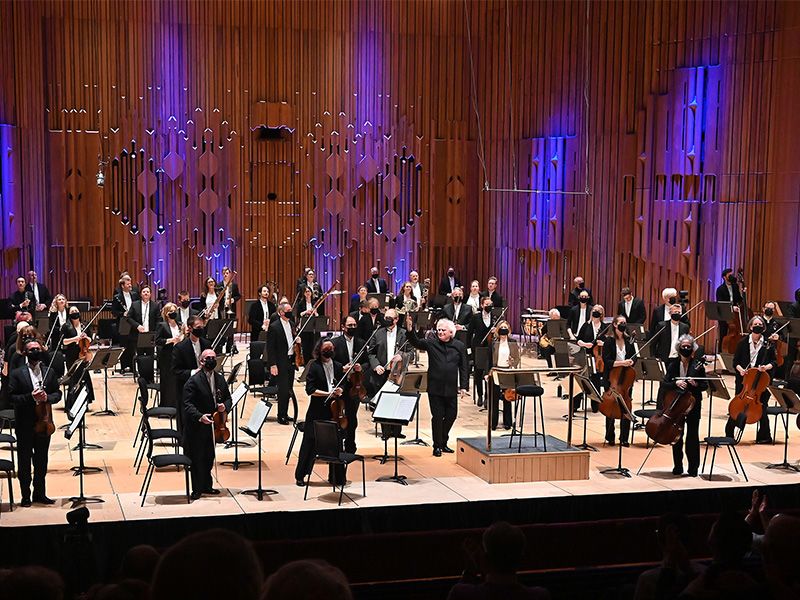LSO Half Six Fix
Concerto for Orchestra
Wednesday 15 December 2021 6.30pm
Digital Concert Guide

Welcome to tonight's Half Six Fix, a different way to experience the London Symphony Orchestra, with introductions from conductor Kirill Karabits.
YOUR DIGITAL CONCERT GUIDE
You can use your phone to view this digital guide during the concert, and discover more about the music and performers.
Navigate using the menu icon (≡) at the top of the screen.

There is free WiFi in the Concert Hall, available through the Barbican Free WiFi network.
So that everyone can have the best experience, please set your phone to silent and don’t use other apps during the music. Photos can be taken during applause at the end of the concert.
Structure your listening with the Visual Listening Guide
The Guide is designed to act as a map of important sonic landmarks in the Symphony, showing where the main musical themes and moments occur in a visually engaging way, whatever your musical background!
NB The licence to the Visual Listening Guide has now expired, but is available to purchase from the Symphony Graphique website with a 20% discount using the code LSOBAR20 at the checkout.
Opens in a new tab
Tonight's Programme
Béla Bartók Concerto for Orchestra
Kirill Karabits conductor
London Symphony Orchestra

‘In art there are only fast or slow developments. Essentially it is a matter of evolution, not revolution.’

Concerto for Orchestra
✒️1943, rev 1945 | ⏰40 minutes
1 Introduzione (Introduction)
2 Giuoco delle coppie (Game of Pairs)
3 Elegia (Elegy)
4 Intermezzo interrotto (Interrupted intermezzo)
5 Finale

A colourful showpiece, and probably the most popular of Bartók’s orchestral works, the Concerto for Orchestra was composed in the US, where Bartók and his wife had moved in 1940 to escape fascism and war in their native Hungary. At this time, Bartók’s career, health and finances were in decline. His 60th birthday in 1941 had passed by unhonoured in his adopted home country.
While in hospital with suspected tuberculosis in May 1943, Bartók was visited by the conductor and patron Serge Koussevitzky, who offered him $1,000 for a new orchestral piece. Bartók wrote most of the work over two months while staying at a ‘cure cottage’ near Lake Saranac in upstate New York, shielded from the hubbub of New York City.
Bartók may have deliberately set out to avoid writing a symphony, regarding that as an outdated form. While the concerto model had existed for at least two centuries, the idea of a concerto for orchestra (as opposed to a solo instrument, or a small core of instruments, plus orchestra) was quite new. The aim was ‘to treat the single instruments or instrumental groups in a concertant or soloistic manner’. This gives rise to a rich variety of orchestral textures. Bartók noted:
‘The general mood of the work represents, apart from the jesting second movement, a gradual transition from the sternness of the first movement and the lugubrious death-song of the third, to the life-assertion of the last one.'

After the ‘Introduction’ comes the jesting ‘Game of Pairs’ in which, in the manner of Noah’s Ark, instruments enter two by two, playing at fixed intervals apart: bassoons in sixths, oboes in thirds, clarinets in sevenths, and so on.
The central ‘death-song’ features elements of Bartók’s ‘Night music’ writing: nocturnal, magical, occasionally disturbing. (It’s hard to believe Bernard Herrmann didn’t borrow elements of this for his Hitchcock film scores.) The uncharacteristically nostalgic, lyrical tune on violas in the fourth movement quotes a popular nationalistic song, ‘You are lovely, you are beautiful, Hungary.’ A whooping call on horns opens the finale, a fizzing series of dances in a final fling that shows off the orchestra’s flair and virtuosity as individuals and as a collective.

Béla Bartók
1881 (Hungary) to 1945 (New York, US)

Béla Bartók, along with his contemporary Zoltán Kodály, built up a Hungarian national art-music that drew heavily on its rich folk tradition. After studying piano and composition at the Budapest Academy he embarked with Kodály on a series of folk-song collecting tours, recording, transcribing and classifying music from Hungary, Transylvania, and even North Africa and Turkey. Folk and folk-like material became central to his style, though Strauss had been an early influence, and later on Debussy. But it was the ballets of Stravinsky that led Bartók to his own ballets, The Wooden Prince (1914–17) and The Miraculous Mandarin (1918–19, orch 1924, later revised).
From 1907 to 1934 Bartók taught piano at the Budapest Academy, during which time he performed regularly in Hungary and abroad as a concert pianist. Objecting to Hungary’s alliance with the Nazis, Bartók fled to the US in 1940. Here, suffering from financial and health problems, he wrote his Concerto for Orchestra and other works.

Not the Original, but the Best?
Bartók didn’t invent the idea of a ‘Concerto for Orchestra’. Before his 1943 work came examples by Paul Hindemith (1925) and the Italians Gian Francesco Malipiero (1931), Goffredo Petrassi (1934) and Alfredo Casella (1937), as well as Bartók’s friend and fellow folk-song collector, Zoltán Kodály.
The late André Previn, who was Principal Conductor of the LSO from 1968 to 1979, wrote his own Concerto for Orchestra in 2016. (Its second movement, ‘Duets’, could even be a response to Bartók’s ‘Game of Pairs’.)
May the Fourths Be With You
The eerie, unstable effect created at the opening of Bartók’s Concerto comes from the chain of fourths in the cellos and basses (the ‘fourth’ refers to the number of stepwise pitch intervals along a standard scale). Standard harmony until the end of the 19th century had been based on thirds and fifths. Other composers who explored melodies and harmonies based on fourths include Gustav Mahler, Arnold Schoenberg, his pupil Alban Berg, Alexander Scriabin and Maurice Ravel.

Take Five
Five is an unusual number of movements for a concerto or symphony (which generally have three or four movements.) But symphonies that go that extra mile are:
Beethoven’s Sixth (the ‘Pastoral’)
Berlioz’s Symphonie fantastique
Mahler’s Seventh (which has two ‘Night Music’ movements)
Penicillin to Piano Concerto
Bartók was reported to be one of the first civilians (as opposed to the military) to be treated with penicillin. ASCAP (the American Society of Composers, Authors and Publishers) underwrote all Bartók’s medical and recuperation costs, to the tune of $16,000. The extra two-and-a-half years this bought him allowed him to compose not only the Concerto for Orchestra, but also the Sonata for Solo Violin, Piano Concerto No 3 and Viola Concerto.
Tonight's Artists

Kirill Karabits
conductor
Kirill Karabits has been Chief Conductor of the Bournemouth Symphony Orchestra for 13 years and their relationship has been celebrated worldwide.
Kirill has worked with many of the leading ensembles of Europe, Asia and North America, including the Cleveland, Philadelphia, San Francisco and Chicago Symphony orchestras, Munich Philharmonic, Orchestre National de France, Philharmonia Orchestra, Vienna Symphony, Rotterdam Philharmonic, Yomiuri Nippon Symphony Orchestra, Orchestra Filarmonica del Teatro La Fenice and the BBC Symphony Orchestra – including a concertante version of Bartók's Duke Bluebeard’s Castle at the Barbican. Kirill enjoys a special relationship with the Russian National Orchestra with whom he returned to the Edinburgh Festival in the 2018/19 season, and more recently embarked on extensive European and North American tours with Mikhail Pletnev which included his New York debut at the Lincoln Center.
A prolific opera conductor, Kirill has worked with the Deutsche Oper, Opernhaus Zürich and Oper Stuttgart , Glyndebourne Festival Opera, Staatsoper Hamburg, English National Opera, Bolshoi Theatre and he conducted a performance of The Flying Dutchman at the Wagner Geneva Festival in celebration of the composer’s anniversary. Music Director of the Deutsches Nationaltheatre Weimar from 2016–19, Kirill conducted acclaimed productions of Wagner's Die Meistersinger von Nürnberg and Tannhäuser as well as Mozart's Da Ponte Cycle (The Marriage of Figaro, Don Giovanni, and Così fan tutte).
Working with the next generation of bright musicians is of great importance to Kirill. As Artistic Director of I, CULTURE Orchestra he conducted them on their European tour in August 2015 with Lisa Batiashvili as soloist and a summer festivals tour in 2018, including concerts at the Concertgebouw in Amsterdam and the Montpellier Festival. In 2012 and 2014 he conducted the televised finals of the BBC Young Musician of the Year Award (working with the Royal Northern Sinfonia and BBC Scottish Symphony Orchestra), and has recently debuted with the National Youth Orchestra of Great Britain on a UK tour including a sold out and critically acclaimed performance at the Barbican.
Kirill was named Conductor of the Year at the 2013 Royal Philharmonic Society Music Awards.
London Symphony Orchestra
At the London Symphony Orchestra we strive to inspire hearts and minds through world-leading music-making. We were established in 1904, as one of the first orchestras shaped by its musicians.
Through inspiring music, a world-leading learning and community programme and technological innovations, our reach extends far beyond the concert hall.
On Stage
Guest Leader
Sergey Ostrovsky
First Violins
Janice Graham
Clare Duckworth
Ginette Decuyper
Laura Dixon
Maxine Kwok
William Melvin
Claire Parfitt
Elizabeth Pigram
Laurent Quénelle
Harriet Rayfield
Sylvain Vasseur
Hilary Jane Parker
Jan Regulski
Second Violins
Julián Gil Rodríguez
Thomas Norris
SarahQuinn
David Ballesteros
Matthew Gardner
Naoko Keatley
Alix Lagasse
Belinda McFarlane
Iwona Muszynska
Andrew Pollock
Paul Robson
Miya Väisänen
Caroline Frenkel
Violas
Germán Clavijo
Stephen Doman
Sofia Silva Sousa
Robert Turner
Lisa Bucknall
Luca Casciato
May Dolan
Errika Horsley
Nancy Johnson
Claire Maynard
Cellos
David Cohen
Jennifer Brown
Noël Bradshaw
Eve-Marie Caravassilis
Daniel Gardner
Laure Le Dantec
Amanda Truelove
Ghislaine McMullin
Peteris Sokolovskis
Double Basses
Rodrigo Moro Martin
Patrick Laurence
Matthew Gibson
Thomas Goodman
Joe Melvin
Jani Pensola
Simo Väisänen
Flutes
Amy Yule
Patricia Moynihan
Piccolo
Sharon Williams
Oboes
Olivier Stankiewicz
Rosie Jenkins
Cor Anglais
Stéphane Suchanek
Clarinets
Chris Richards
Chi-Yu Mo
Bass Clarinet
Thomas Lessels
Bassoons
Daniel Jemison
Joost Bosdijk
Contra Bassoon
Dominic Morgan
Horns
Eirik Haaland
Clément Charpentier-Leroy
Annemarie Federle
David Sztankov
Trumpets
James Fountain
Kaitlin Wild
David Geoghegan
Trombones
Peter Moore
Tom Berry
Bass Trombone
Paul Milner
Tuba
Ben Thomson
Timpani
Nigel Thomas
Percussion
Neil Percy
David Jackson
Harps
Bryn Lewis
Helen Tunstall





